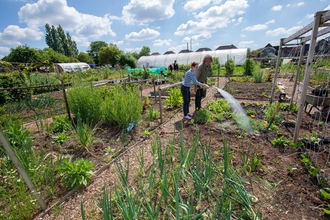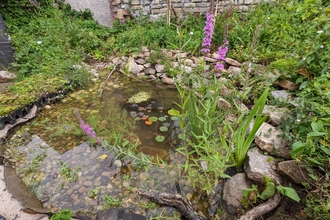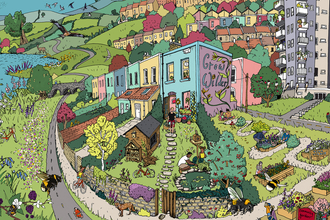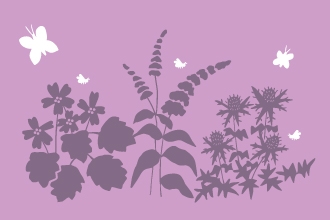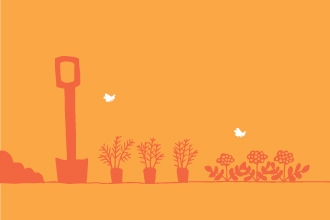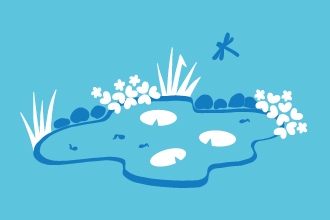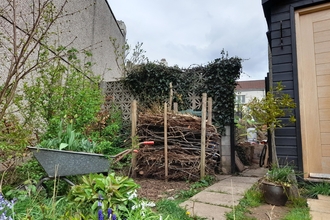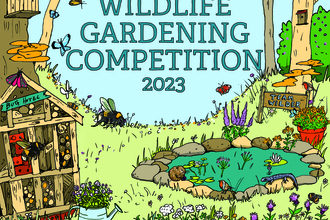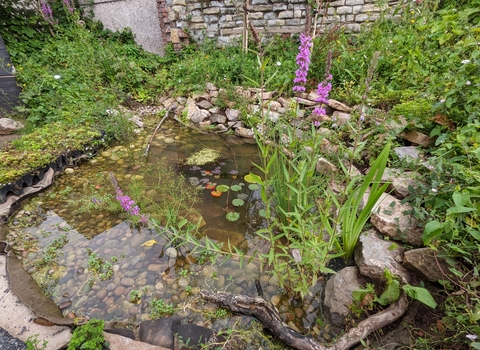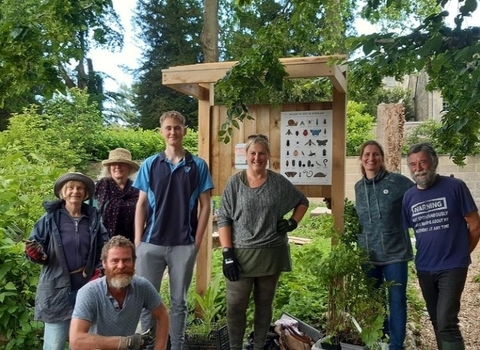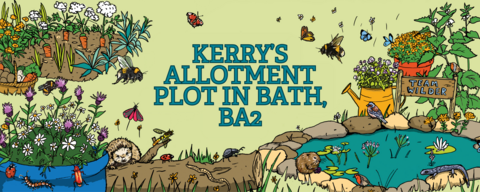
Hannah Bunn
Food Growing: Kerry Rogers' Moorfields Road allotment plot
Name: Kerry Rogers
Category: Food Growing in the wildlife gardening competition 2023
Area: Moorfields Road allotment plot, Bath, BA2
Stephanie Chadwick
What makes your garden wildlife friendly?
Kerry: There is a small washing up bowl pond surrounded by long grass as habitat. There is a pile of wood and twigs near the pond and a large area of nettles. I have planted teasles for pollinators and for birds to eat the seeds. I have grown birds foot trefoil from seed as food for caterpillars and pollinators. I interplant flowers with the vegetables. When strimming paths I leave some dandelion for early food and ragwort as previously we have had cinnabar moth caterpillars feeding on these plants. I have a compost area which provides habitat. I garden organically.
Tell us what you love about your allotment
I never stop being amazed at seeing tiny seeds grow into wonderful edible plants. Looking after my allotment gives me the opportunity to be outside in nature and helps me relax and destress. I love being able to share my space with nature and finding new creatures living on my plot - although often this can distract me from the jobs I need to do!
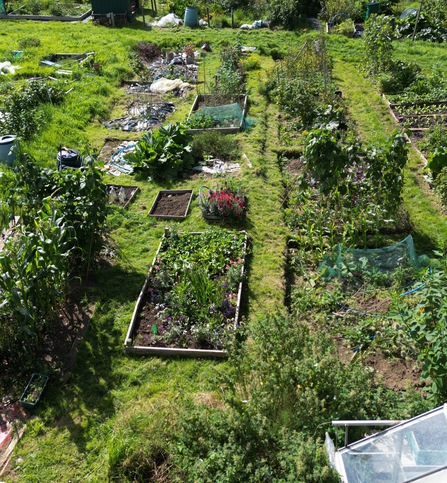
Stephanie Chadwick
What wildlife have you seen in your garden?
Fox, evidence of a badger, frogs, newts, wasps, variety of bees including ashy mining bee making a nest, Violet ground beetles, privet hawk moth, wide variety of butterflies, earwigs, millipedes, centipedes, lots of different spider, shieldbugs, cockchafer grubs.
Kerry was a finalist!
Stephanie Chadwick
Don't be too quick to remove 'weeds' as these often provide homes/food for insects. Interplanting flowers with vegetables helps attract insects which eat aphids, blackfly etc and improves pollination.Moorfields Road Allotments
Feeling Inspired?
Kerry's allotment plot is a great example of growing 75% food and combining as much habitat for nature as possible - to benefit production, pollination, pest control and habitat space for wildlife.
Water features It was great to see the water feature in the corner of the allotment, this benefits a whole range of wildlife. I would also recommend that you create a bog garden next to the current feature and maybe even make the pond a little bigger if allowed/possible.
Team Wilder bog gardens A bog garden could also be made by the entrance of the allotments, this area is shaded and gets quite wet. A larger pond could also be made down the hill as you walk up to the allotments (as discussed). Details on suitable pond management are below:
- No matter what size the pond is, it will still attract wildlife. The pond does not need to be more than 30-35cm deep to keep the pond well-oxygenated and well-lit.
- Autumn, winter or early spring is a good time to make a pond, giving it time to settle before breeding season of different species. Please note that species, such as newts and frogs, could be hibernating nearby if you wish to clear and dig. Therefore a staggered approach should carried out.
- There shouldn't be too much vegetation to the south of the pond, so that it is not shaded out.
- Make sure vegetation and sheltered areas are nearby, to act as good cover for birds and amphibians. E.g. long grass.
- Avoid locating the pond under a large tree as the falling leaves can impact on the nutrient levels. Cut any dead marginal plants back overtime.
- Blanket weed may cover the pond in the first couple of years. This is natural in the early stages of a pond. You can accelerate these early stages by planting marginal plants such as meadowsweet, water avens, red campion and yellow flag-iris (most suppliers offer a marginal plant seed mix and also plug plants for ponds).
- Avoid introducing fish into the pond as these can predate on newts eggs and invertebrate larvae.
- To ensure the safety of children, a post and rail fence (or similar, to allow small mammals to still pass through) can be installed around the boundary of the pond. Or a dead hedge could be created around the edge of the pond, as a natural barrier and providing shelter for wildlife and using waste from the allotment.
Team Wilder ponds
Stephanie Chadwick
Ants I recommend that you have a look at this page as it details what to do if ants are dominating a patch : How to Get Rid of Ants | BBC Gardeners World Magazine .
Bug hotel I recommend that you follow the step-by-step guide to make a bug hotel. Materials include wooden pallets, bricks, dead leaves, woody material such as sticks/twigs etc. I also recommend that you put a planter on top of it and plant some wildflowers for pollinators too.How to make a bug hotel
Early and late flowering species These two webpages below have a list of early, mid and late flowering species to ensure that you can benefit pollinators all year round.
The best plants for bees and pollinators
How to attract bees
Encouraging hedgehogs Piles of logs and brash can provide an area for hedgehogs to hibernate. You may also want to leave the grass to grow long in certain areas where you can identify corridors through your allotment to the neighboring woodland and gardens. It possible, try to encourage others around you to do the same so that the allotments can be joined up. You could even ask the neighboring gardens to install a hedgehog hole through their fences!
Encouraging slow worms Slow worms shelter in tussocky grass such as the grass that you have nearby the nettles and mini pond. You could extend this grass area across the back of the allotment too. The creation of log and brash piles will also benefit them.
Dead hedging You could create some dead hedges to partition different areas of the allotment and this will also act as a good corridor and shelter for slow worms, hedgehogs and other wildlife. Dead hedges can be found here: Natural Barriers Team Wilder | Avon Wildlife TrustTeam Wilder dead hedges and natural barrier
Shrubs for wet would and managing the goat willow This website provides a list of shrubs for wet soils that you could plant either by the goat willow or down by the woodland– I recommend that you plant dog wood and hawthorn as these tolerate most conditions and grow quickly. You can buy whips of these on the website: British Trees & Hedges | UK Provenance & Origin | Habitat Aid | Tagged "Conditions_Wet Situation" .
It will need to be deprived of light through planting shrubs around it (whilst keeping it covered). I suggest species that will grow well in wet conditions (e.g. hawthorn, dogwood). The only other alternative (that does not use chemicals) is to dig it out but this would be hard work! You could create a bog garden in the remaining wet area alongside the shrubs.
Stephanie Chadwick
Resources

West of England Combined Authority and Natural History Consortium
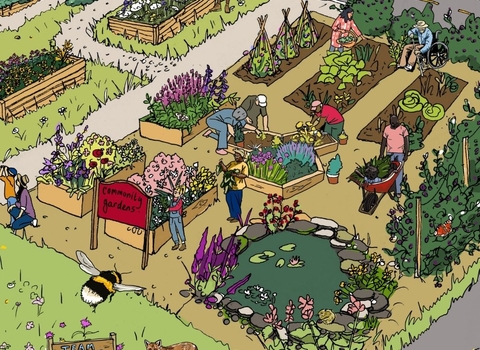
(C) Hannah Bunn
Be part of Team Wilder
Feeling inspired by this wildlife garden? Try something for yourself at home, in your community, school, business or land, no matter the size.
All actions for nature collectively add up and makes a difference for people and wildlife.
Share your actions for nature, like Kerry, and motivate others to do the same.
Log your actions for nature on the map

